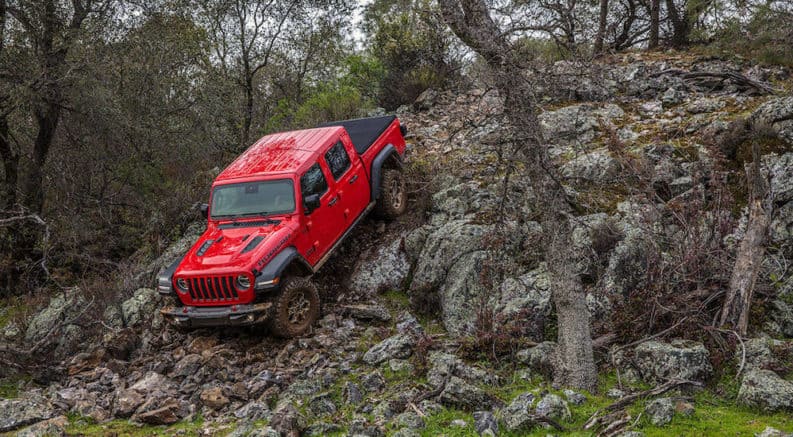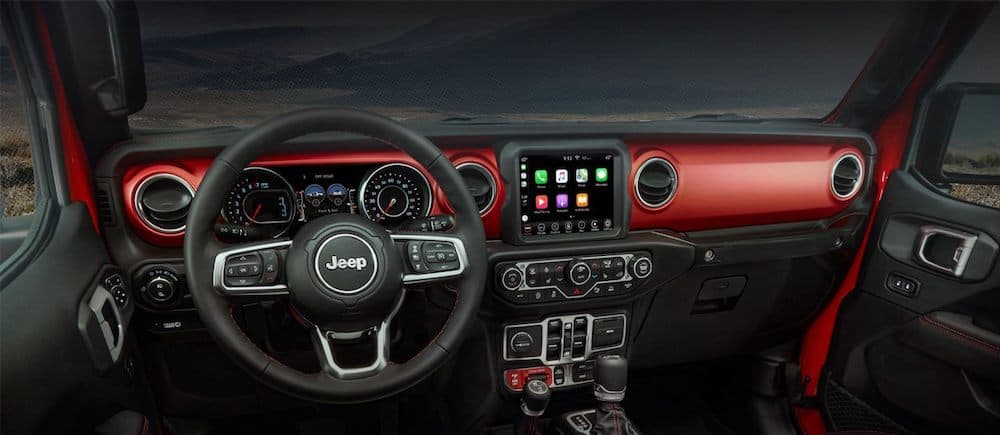In a world where sizing up the F-150 against the Silverado feels like something most of us could do in our sleep, it’s always interesting when we get the opportunity to explore the differences between a more unique pairing. Sure, we get the occasional RAM 1500 and Titan thrown in for good measure but, regardless of how enticing the subjects are, the full-size truck game can feel a little too familiar at times. So when we get the chance to mix things up a bit, it’s always a good thing, and that’s exactly how we felt in getting the opportunity to measure up the 2020 Jeep Gladiator vs 2019 Chevy Colorado. One of the most distinctive and highly-anticipated offerings of the model year versus one of the most underrated midsize offerings available? Sign us up.
So with that in mind, let’s explore the Gladiator and Colorado a little bit closer, and see how they measure up against one another.
The Basics
The Gladiator arrived amidst heavy anticipation at a starting MSRP of $33,545 and is served up in a total of four trim levels (Sport, Sport S, Overland, and Rubicon) the latter of which has been called the most off-road capable midsize truck ever. We’ll get to some performance numbers below, but some Best-in-Class numbers have allowed the trail-rated 4×4 midsize to earn such distinctive descriptions as Car and Driver’s exclamatory “It’s a real truck” quote, making us wonder what they were expecting.
The Colorado, of course, comes with a more established reputation, having usually switched between the #1 and #2 spots for midsize truck sales since its introduction back in 2004. Priced to start around $21,300 MSRP the Colorado is also served up in four trims (WT, LT, Z71, and ZR2) and also boasts some Best-in-Class numbers, which makes sense considering its status as a perennial favorite.
So at first glance, both measure up as confident offerings, nicely tiered in their trim options and perfectly on-brand. And that said, there’s nothing left to do but break each one apart to see what we’re working with.
Performance
Across all trim levels, the 4×4 Gladiator comes powered by a 3.6-liter V6 engine paired to either a 6-speed manual transmission that comes standard or the option of an 8-speed automatic. The engine features dual overhead camshafts, high-flow intake and exhaust ports, variable-valve timing and electric throttle control as well as electric start/stop technology; and power ratings fall in confidently at 285 hp and 260 lb-ft of torque.
Based on midsize 4×4 crew cab segment, the Gladiator features Best-in-Class Towing and Payload falling at 7,650 LBS and 1,600 LBS respectively. These numbers echo across all trim levels with the distinctions primarily related to a combination of aesthetics, amenities and (primarily) the inclusion of trail-rated features.
The Colorado, on the other hand, is served up in both rear and 4WD configurations. Like the Gladiator, the (base) WT trim comes powered by a 3.6-liter V6 engine albeit paired with an 8-speed automatic transmission, a powertrain that reappears as an option across all Colorado trim levels. Managing to best the Gladiator with 308 hp and 275 lb-ft of torque, the direct injection V6 engine also features variable valve timing and a dual overhead camshaft, so there are some immediate similarities worth noting.
That said, the Colorado also offers the secondary option of a 2.8-liter Duramax Turbo-Diesel four-cylinder engine paired with a 6-speed automatic transmission in all, but the WT trims. Delivering 181 hp and 369 lb-ft of torque, this powertrain helps to flesh out what could be described as the Colorado’s wider appeal. When equipped with the V6, the Colorado earns a Best-in-Class Horsepower rating, while the Turbo-Diesel offers Best-in-Class Towing (7,700 LBS) and Fuel Economy (30mpg highway).
That said, in our opinion, Chevy gets enduring points for providing a wider range of options, but it does little to minimize our appreciation for Jeep’s sense of purposeful refinement in offering a singular powertrain that they felt suited the needs of their target demographic. Either way, smart choices were made.
Exterior
In all fairness, the subjective arena of all things aesthetic is where a lot of decisions are going to be made. Whether an extension of brand loyalty or simply an appreciation for the unique design philosophy employed on a particular model, looks matter; and both the Gladiator and Colorado are impeccably on-brand in that regard.
Of course, part of the appeal of the Gladiator is its JL Unlimited-centric design. Offering the convenient cabin experience of a four-door cab, combined with a capable five-foot bed the Gladiator renders a silhouette both distinctive and familiar, whether you opt for the hard or soft top or embrace the full open-air experience. And, in that regard, it’s largely the Jeep fan-base that finds the Gladiator aesthetic so enticing. The choice of ten paint colors reinforces brand identity, with such rugged earth-tone colorations as Gobi and Gator, with vibrant options such as Firecracker Red, Hydro Blue, and Punk’n (Orange) with the more subtle range of gray, black, and white.
The Colorado on the other hand is both on-brand (when compared to its sibling the Silverado) and more traditionally truck-like. The option of either a Crew or Extended cab build, paired with the short (61.7-inch) or long (74-inch) bed empowers the Colorado to be slightly more accommodating for a wider range of work tasks than the Gladiator. But we’re talking looks here, and a big part of that is the options of available colors, many of which echo those of the Gladiator (despite the absence of muted, earth tones).
Thus, it really comes down to which style you like better. Truth be told, we’ve found the Colorado aesthetic to be slightly more ‘tired’ in recent years (in spite of refreshes) so the Gladiator is more likely to snag our attention. And, as long as the performance numbers line up with an individual’s unique needs, we wouldn’t be surprised by anyone else who felt the same.
Interior
A similar style of review could apply to discussion of the interior. Aside from their lineup of SUVs and crossovers, a Wrangler-styled Jeep might never be praised for overwhelming luxury. That said, since its inception the JL had been a step up in that regard (one that was celebrated by some and criticized by others) offering more aesthetically pleasing, and amenity-based design. Not that it could ever be mistaken for luxury. Thus, the Gladiator is bound to prove pleasing to a more limited selection of consumers.
The Colorado, on the other hand, displays the level of thoughtful cabin design that one would expect of a GM-offering. They are built for comfort, and to accommodate a wider range of passengers, and thus the Colorado isn’t as limited by the niche appeal of the Gladiator. It just comes down to what you’re into.
It’s Your Call
Whether you prefer the off-road versatility of a trail-rated Gladiator or the mainstream appeal of the Colorado, either one is bound to prove pleasing to those who are interested in it. But all things being equal, we find the Gladiator to be a far more compelling offering, proud of its stylized legacy and well-deserving of its slightly higher price point. After all, getting work done is one thing, but we like the option of going off-road and (unless we’re talking about the ZR2, the Silverado isn’t quite ready for that kind of beating. Because adventure calls, damn it.






